Twinkle: A British Mission to Explore Exoplanets
Non-EO
Astronomy and Telescopes
Quick facts
Overview
| Mission type | Non-EO |
Twinkle: A British mission to explore Exoplanets
Overview Spacecraft Launch Sensor Complement References
Over the past two decades, mankind has discovered nearly two thousand planets orbiting stars other than our Sun. Earth is potentially just one of billions of exoplanets in our galaxy alone. However, we have very little information about these alien worlds. We can surmise that some of them are freezing cold, some are so hot that their surface is molten, some – like Jupiter – are mostly made of gas and some are rocky and barren. But beyond that our knowledge falters. What are they made of? How did they form? Are they habitable? And what's the weather like there? Finding out is a huge challenge, since exoplanets are many light years away and can be difficult to detect.
In 2015, a team of UK scientists and engineers are working together with SSTL to place a small satellite into Earth's orbit that could start to answer these questions within just four years.
The next step is Twinkle: a small dedicated satellite designed to understand these newly found worlds through the measurement of their atmospheric signatures. Twinkle will observe the chemical composition and weather of at least 100 exoplanets in the Milky Way, including super-Earths (rocky planets 1-10 times the mass of Earth), Neptunes, sub-Neptunes and gas giants like Jupiter. It will also be capable of follow-up photometric observations of 1000+ exoplanets in the visible and infrared, as well as observations of Solar system objects, bright stars and disks. Twinkle is a cost-effective space mission taking advantage of lowered costs of access to space.
The goal of the Twinkle mission is to observe more than one hundred known exoplanets and to unveil their weather, history and the chemical composition of their atmosphere. When an exoplanet passes in front of the star that it orbits, a tiny amount of starlight is filtered through the molecules and clouds in the planet's atmosphere. Twinkle will measure this light and pick out the characteristic spectral ‘fingerprints' that show if gases like water vapor or methane are present on the planet. 1) 2) 3)
Vision and high level objectives: 4)
Twinkle will be the first mission in a wider program to enable a new generation of dedicated, cost-effective, short timescale scientific missions that respond rapidly to the need of the scientific community worldwide. This class of mission will:
• Provide capability to do focused, world class science at a fraction of a cost of current astrophysics missions and
• Demonstrate a new business model for space science missions based upon commercial mission delivery. 5)
Twinkle has been chosen as the first mission in the program primarily due to the rapid advances being made in exoplanet research and its wide-reaching impact on science, society and STEM (Science, Technology, Engineering, Mathematics) education activities.
Twinkle, has the following high level mission objectives:
1) Perform space-based spectroscopic observation on at least 100 pre-selected exoplanets in the Milky Way to enable characterization of their atmospheres
2) Deliver the mission within a 3-4 year timeframe (Kick Off to Flight Readiness Review)
3) Deliver the mission within a cost envelope of £50-60 million
4) Generate revenue from commercial sales of the science service to part fund the next mission
Rationale
Nearly 2000 exoplanets have been confirmed and several thousand planetary candidates have been detected. Statistical estimates indicate that most stars host planets. Current and upcoming space missions, as well as ground-based surveys, will dramatically increase the planet count over the next 10 years. Many of the exoplanets found so far are very different from those in our solar system: from hot-Jupiters (giant planets that orbit very close to their star) to super-Earths (rocky planets up to ten times the mass of Earth). However, we know very little about these planets beyond their mass, size and distance to their star.
In the past decade, pioneering results have been obtained using transit spectroscopy with Hubble, Spitzer and ground-based facilities, which have enabled the detection of a few of the most abundant chemical species, the presence of clouds, and have also permitted the study of the planetary thermal structure. Despite these early successes, currently available data are still too sparse to allow a comprehensive and meaningful understanding of the physical and chemical properties of these planets. Most importantly, with the degraded performance of Spitzer, current data are restricted to wavelengths shorter than 1.7 µm. The scientific community is faced with having to wait 5 to 10 years for the next generation of space and ground based facilities with IR capabilities to come online such as the JWST (James Webb Space Telescope) and the E-ELT (European Extremely Large Telescope). Even then, the exoplanet community will still not have gained access to a specially designed science payload, and will have to share observation time with other science communities.
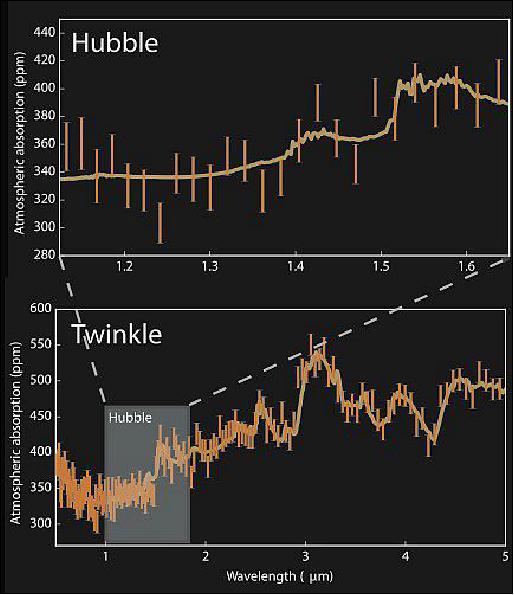
Twinkle's highly stable instrument will allow the photometric and spectroscopic observation of a wide range of planetary classes around different types of stars, with a focus on bright sources close to the ecliptic. The planets will be observed through transit and eclipse photometry and spectroscopy, as well as phase curves, eclipse mapping and multiple narrow-band time-series. The targets observed by Twinkle will be composed of known exoplanets mainly discovered by existing and upcoming ground surveys in our galaxy (e.g. WASP, NGTS and radial velocity surveys and will also feature new discoveries by space observatories (GAIA, CHEOPS, TESS).
Follow-up Visible and/or IR photometric observations using Twinkle will improve the orbital ephemerides and other planetary/stellar parameters and properties of a large sample of previously discovered exoplanets. Among those, the brightest targets can be studied in great detail through spectroscopic measurements. The wavelength range adopted covers all the expected key atmospheric gases, e.g. H2O, CO2, CH4, NH3, HCN, H2S, including exotic metallic compounds, such as TiO, VO, SiO and condensed species. It will also permit the simultaneous monitoring of the stellar variability and the presence and distribution of clouds and hazes in the exoplanet atmosphere. Monitoring the weather and thermal properties of these planets, through repeated measurements in the optical and infrared wavelength bands will be a key aspect of this mission.
Rationale - "Economic Bit"
Astrophysics is a data-driven research topic. Observations of faint, distant objects often require a satellite-based science payload that can overcome the limitations imposed by our own atmosphere and our day/night cycle. This is particularly true for exoplanets where our own atmosphere provides a real barrier to observations. Exoplanet spectroscopy is one of the fastest growing fields in astronomy, but there is an unmet demand in the community for high-quality spectroscopic data for exoplanet atmospheres from a dedicated facility.
More generally, scientists worldwide are challenged by the difficulty in accessing facilities that could provide new data for their research. The two main problems are the oversubscription of existing facilities and the geographical location restrictions imposed on users.
Current oversubscription of facilities: Space facilities for astrophysics are built and launched by national and international space agencies, through a selection of competitive processes and often over long timescales. In the case of exoplanet science, and in particular in the context of observations of exoplanet atmospheres, there is a strong demand for observation time on currently existing space facilities. The HST (Hubble Space Telescope) has been running on a ~640% oversubscription for exoplanet science over the last five years, and the Spitzer telescope reached an oversubscription rate of 1200% for exoplanet spectroscopy by the end of its cold operations phase.
Geographical location restrictions: Under the current model applied to satellites designed for astrophysical observations, access to facilities is restricted to researchers located in countries that have participated in the construction of the satellite. This imposes a geographical delimitation on which scientific communities can contribute to a particular field of science. We have investigated the problems faced by worldwide users through several market surveys which indicate this problem is significant, and that there is an opportunity for a new approach to astrophysics missions.
The business plan is to provide a dedicated facility able to deliver the high-quality data needed by the community, regardless of geographical restrictions, in a very short timescale from a spacecraft launched within 3 years of kick-off.
What is it and What does it Offer?
Twinkle is a small satellite designed to understand exoplanets in the Milky Way galaxy through the measurement of their atmospheric signatures. While there are many current and planned missions and programs designed to discover new planets, there is currently a gap in scientific science payload facilities capable of making the follow up observations needed to characterize and understand these alien worlds. This mission will reveal for the first time the chemical composition, weather and history of hundreds of recently found extrasolar planets in our galaxy. Some of the key offerings and capabilities are outlined below.
Twinkle is a dedicated exoplanet atmosphere characterization facility which will allow customers to:
• Purchase observations of exoplanet targets of interest from the mission catalog
• Purchase space-based telescope time for solar system observations
• Get exclusive access to the data within days of the observation.
Twinkle will deliver:
• The first spectral observations of at least a hundred exoplanets
• The first dataset optimized for characterizing exoplanet atmospheres
• The first thermal maps of exoplanets and their cloud cover at multiple wavelengths in the optical and infrared parts of the spectrum
• Repeated observations of exoplanets to monitor changes in climate and atmospheric composition
• Opportunities for all countries to access space data
• An allocation of public data for citizen scientists, amateurs and students.
The benefits of Twinkle will serve both existing and new users in this rapidly expanding field and importantly:
• It can be used by universities, countries and organizations that usually have little or no access to the large international facilities
• It will help to alleviate the oversubscription burden on the existing international multidisciplinary observatories
• It complements the planned hunter and characterization missions
• Pioneers a program which can routinely enable answering suitable key science questions with smaller dedicated observatories on a commercial basis and therefore
• Can start to relieve some of the budgetary and complexity trade-offs faced on the larger multidisciplinary observatories
• In general, this wider access to new data will stimulate new research and the resultant discoveries and publishing will encourage increased STEM uptake and public engagement.
Success of the commercial model demonstrated on Twinkle will enable a continuing commercial astrophysics / space science program more generally offering:
• More flight opportunities for more PIs (Principle Investigators)
• Responsivity to emerging opportunities
• Responsivity to emerging opportunities
• Regular, strategic opportunities to focus on national goals and capacity building
• De-risking of larger more expensive projects
• Less pressure to accommodate various non-related science payloads
• Less pressure on agency and government budgets
• More opportunities to train next generation of scientists and engineers.
Spacecraft
The Twinkle satellite will be built by SSTL and carry an instrument made from off-the-shelf components that will be built by a payload consortium of UK institutes led by UCL (University College London). The industrial and technical partners already involved in the instrument design include: Cardiff University, RAL Space, Open University, Selex ES, UCL-MSSL (University College London-Mullard Space Science Laboratory) and UK ATC (United Kingdom Astronomy Technology Center).
The top level mission architecture for Twinkle is shown in Figure 2. Balancing the science and programmatic requirements, the proposed baseline is for a single satellite operating in a dawn-dusk (6 hrs to 18 hrs) SSO (Sun-Synchronous Orbit) with an altitude in the range of 600 to 700 km.
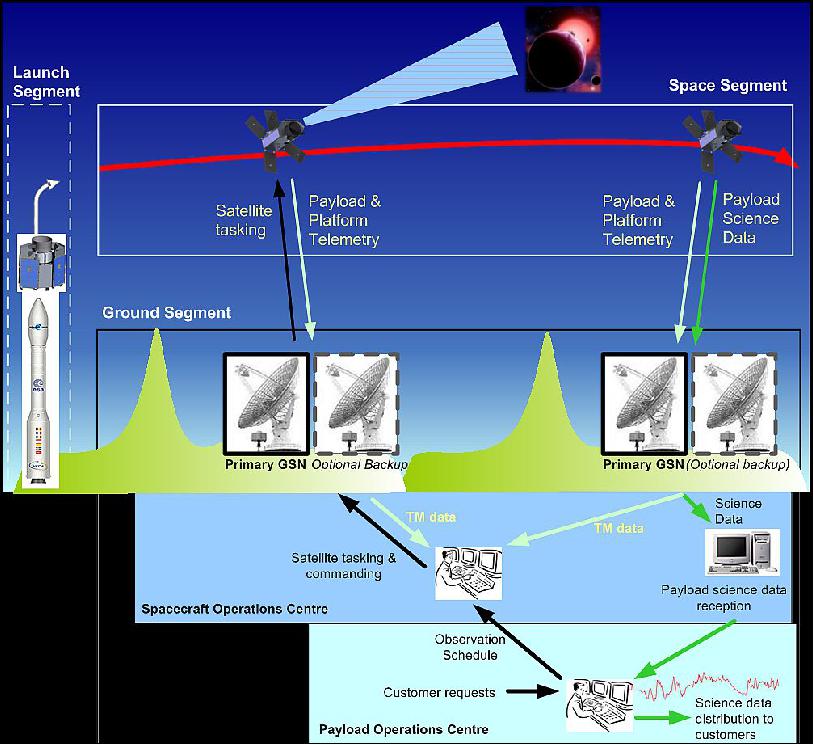
The space segment is comprised of the single spacecraft (platform and science payload). The platform is from the SSTL range of flight proven platforms and future builds may also benefit from additional cost and schedule savings associated with the ongoing productionisation activities . The science payload is based upon high TRL components and is being delivered by an experienced consortium led by UCL (University College London).
SSTL will build the spacecraft using the SSTL-300 -S1platform developed for high-resolution Earth imaging. The first generation SSTL-300 platform (NigeriaSat-2, launch Aug. 17, 2011) has delivered over four years of in-orbit operations and in turn builds upon SSTL's flight proven systems and operational architectures. The second generation SSTL-300 -S2 based constellation was launched on July 10, 2015 (launch of DMC-3 constellation on a PSLV launcher from SDSC).
Managing changes from this flight proven baseline includes benefits that extend beyond the flight-proven architecture and technologies, but also in being able to re-use much of the ground support equipment, test tools and existing ground segment and operations infrastructure. This enables maximum focus to be directed on supporting the payload accommodation and performance requirements to enable world-class science to be delivered on time and on budget. 7) 8)
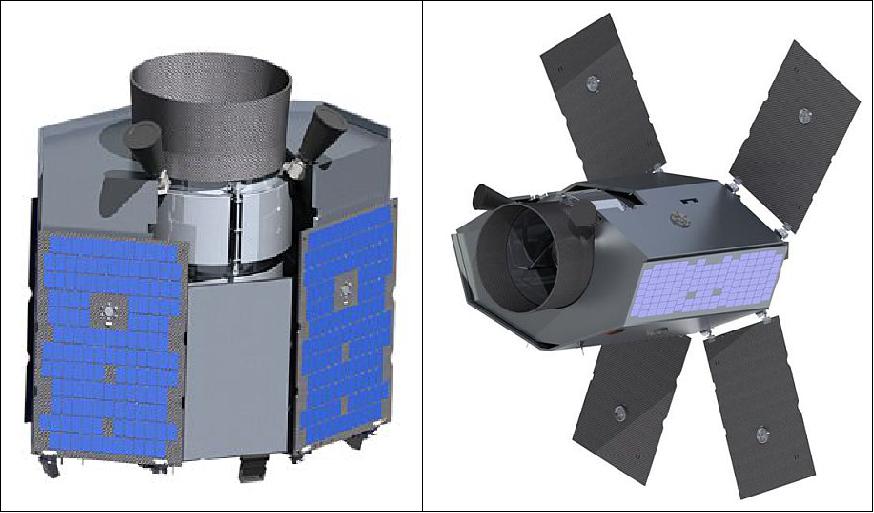
The platform must physically accommodate a telescope assembly with an aperture of 45 cm and length of 100 cm. The science payload includes cryocoolers and a dedicated radiator to maintain the telescope to its required operating temperature of 150 K. The total mass of the payload is 100 kg with an average power requirement of 100 W, including all margins. The boresight of the telescope will be pointed within a 40º cone centered around the anti-sun vector.
The platform structure is an evolution of the SSTL-300 heritage design, optimized for the new payload size . It comprises of composite honeycomb aluminium panels to reduce mass while retaining strength. A central core of these panels surrounds the science payload and provides the primary load paths, as well as accommodating the majority of the platform equipment.
In addition to use of the core building blocks from previous missions, there are some specific missions from which the on-ground and in-orbit experiences can be directly utilised. For example, SSTL has provided the space segment platform to Prime Contractor MDA (MacDonald, Dettwiler and Associates) for the Canadian DND (Department of National Defence) mission, Sapphire (Space Surveillance Mission of Canada). Leveraging from this highly agile resident space object tracking mission for Twinkle for e.g. handling the seasonal variation of the eclipse times during eclipse seasons in this low dawn-dusk SSO is relevant across areas such as operations, attitude and orbit control, thermal control and power subsystem. Additionally, on ground AIT (Assembly Integration and Test) issues such as the management of stringent science payload cleanliness and contamination control requirements are also similar for Twinkle. Contamination is controlled through the use of suitable design techniques, selection of suitable materials, hardware pre-cleaning and maintenance of cleanliness during assembly, testing, transportation, storage, launch and onorbit operations. Failure to do so can result in reduced mission performance or a reduction of mission lifetime and so a mission-specific contamination and control budget and corresponding contamination control plan is necessary for Twinkle.
The core operations and avionics for the platform are from the range used on the majority of SSTL-100, SSTL-150 and SSTL-300 missions. These have the advantage of not only being flight proven in similar operating environments to Twinkle, but they have also been operated together routinely across a range of mission types. This means that platform avionics development effort is limited to the payload interface. Using the SSTL core avionics suite allows Twinkle to leverage the CONOPS (Concept of Operations) and FDIR (Fault Detection, Isolation and Recovery) approach that has been developed and proven over several previous generations of SSTL spacecraft. Twinkle therefore benefits from the streamlined operations approach, a system designed for robustness and safety, plus high levels of availability all of which have been refined over three decades.
Key features of the CONOPS and FDIR are therefore:
• Robustness and redundancy; simple and robust operational modes that deliver high payload availability performance with multiple backup functionality and equipment on board to assure mission lifetime and guard against unforeseen and random outages and failures.
• On-board autonomy and simple satellite safe-modes, resulting in the elimination of the need for expensive, constantly manned ground segments.
• Extensive use of proven, off-the-shelf components for both platform and payload and ground segment.
• Modularity; key systems, designed to interface together, that can be arranged in configurations to deliver a wide variety of performance and capacity variations depending on mission requirements.
The current spacecraft system block diagram is shown in Figure 4. Ongoing trade-offs relating to the platform to payload interface with respect to balance between cost, risk/complexity and performance/ utility are highlighted in grey.
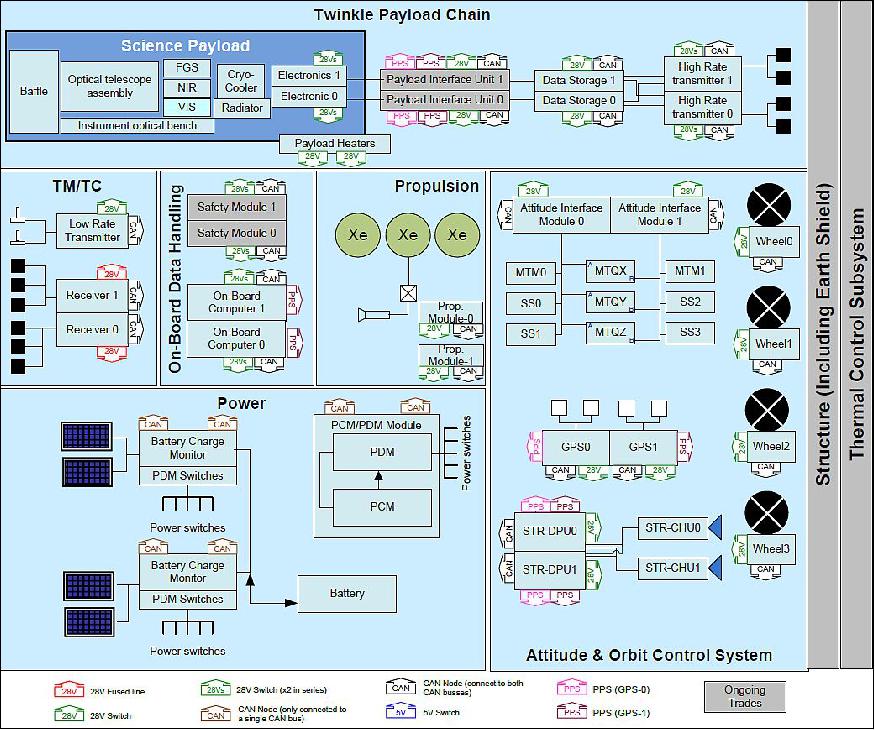
The SSTL-300-S1AOCS (Attitude and Orbit Control System) design has been used as a starting baseline for the Twinkle mission. The AOCS has to point the payload towards a target star and maintain the necessary pointing accuracy [APE (Absolute Pointing Error) of 3 arcmin, 99.7% confidence] during an observation period. The AOCS will also rotate the satellite about the payload boresight during an observation to ensure that payload radiators observe cold space. Pointing requirements are currently being developed in consultation with the mission scientists and are expected to be further iterated as the mission design progresses.
The payload contains a fine guidance sensor (FGS) and a focal plane steering mechanism (FSM). The FGS measures the position of the target star within the science payload and may be used as both an attitude sensor and for adjusting the FSM to correct errors in the attitude control system to the level required for science observations. The FGS has a 1 Hz update rate and an accuracy of 0.05 arcsec (1σ).
The measurement errors of the FGS are nearly two orders of magnitude less than the STR (Star Trackers), however the FGS is only able to measure pointing errors in the across LOS ( Line of Sight) directions. Requirements on pointing accuracy and stability in the Around LOS direction can be relaxed due to the narrow field-of-view of the imager however in the Across LOS direction the pointing and stability requirements are tight and it is natural to consider the use of the FGS as an attitude control sensor to achieve the performance required for Twinkle science.
The Twinkle AOCS Science Mode (SM) will be required to:
• Slew between target attitudes.
• Settle to an attitude error within the FGS FOV (Field of View) and attitude rates compatible with FGS operation.
• Switch from STR in-the-loop to FGS in-the-loop operation on the across LOS directions (the STR will be used for Around LOS control).
Re-targeting of the platform is required twice per orbit to prevent the Earth limb getting too close to the science payload FOV. Twinkle reuses the existing SSTL-300-S1 slew mode design. Large (0.2 Nm, 12 Nms) reaction wheels are used to perform an open-loop slew between two target attitudes and then fine control is re-enabled using smaller reaction wheels to settle onto the target and maintain fine control.
Pointing accuracies of < 1arcsec are achievable using the star trackers. Simulations show that these can be reduced significantly with the use of the FGS as an attitude sensor. Although the FGS in-the-loop operation offers much improved pointing stability in the across LOS directions, the initial assessment of the AOCS performance suggests that it may be possible to achieve the required performance using only STR in-the-loop control and further work on the AOCS will look at this option.
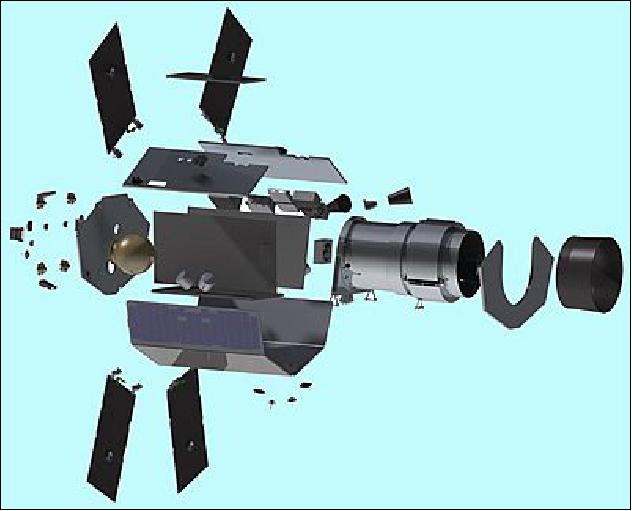
Development Status
• June 16, 2016: Twinkle has completed a key preliminary design milestone. The results of the payload study demonstrate that Twinkle's instruments will be able to achieve the mission's science objectives. Twinkle's two spectrometers will analyze light transmitted through, and emitted or reflected by, the atmospheres of exoplanets in order to give radical insights into worlds orbiting distant stars. 9) 10)
Launch
The Twinkle minisatellite is planned for launch in 2024.
Orbit: Sun-synchronous dawn-dusk orbit, altitude of ~ 650 km.

Mission Phase | Key Activities |
LEOP (Launch and Early Operations) | - Launch and separation of spacecraft from launcher - Initial signal acquisition and platform testing - Attitude acquisition and stabilisation and placement of the spacecraft into a controlled attitude |
Commissioning Phase | - Completion of platform testing including redundant systems as appropriate - Launcher Error Injection Corrections (TBC) - In-orbit payload checkout, characterisation, and calibration, end-to-end operations testing [supported by POC] |
Science Operations Phase | - Routine mission operations - Periodic platform maintenance - Periodic payload calibration [supported by POC] - Collision avoidance manoeuvres (as required) |
EOL (End of Life) Phase | - Platform passivation - Deorbit activities (as required) |
Sensor Complement
The sensor complement, a combination of high TRL (Technology Readiness Level) instrumentation and a few lower TRL elements, is being built by a consortium of UK institutes. The science payload consortium is led by UCL (University CollegeLondon) and involves UK research institutes and companies with a strong heritage in infrared (IR) instrumentation (JWST-MIRI, Herschel, Planck, ISO). The consortium includes: Cardiff University, MSSL (Mullard Space Science Laboratory), Open University, Leonardo (Previously Selex ES), RAL Space (Rutherford Appleton Laboratory), and UK ATC (UK Astronomy Technology Center). 11)
Science requirements: The payload is constituted by a telescope and science instruments covering visible and near infrared wavelength ranges. It will address pointing stability by including an additional FGS (Fine Guidance System in) the payload design as well as the necessary thermal architecture to ensure that the infrared instrument detectors operate with sufficient sensitivity.
Parameter | Value | Comment |
Visible channel (wavelength range) | 0.4-1.0 µm |
|
IR channel | 1.3 – 4.5 µm |
|
Resolving power (R) | 300, 70 | R ~ 300 < 2.4 µm, R ~ 70 > 2.4 µm |
Detector background area | 10 x | In two adjacent strips of sky |
Primary mirror diameter | 450 mm |
|
FOV of FGS | ±3 arcmin | Allows the tip-tilt mirror to correct for pointing jitter |
Overall optical efficiency | 0.4, 0,6 | < 2.4 µm, > 2.4 µm |
Total payload mass | < 100 kg | Including cryocoolers, baffles and payload electronics units |
Average payload power | < 100 W | Including cryocoolers and payload electronics units |
Payload performance estimation method: The performance of the instruments which are part of the payload is assessed using a radiometric model (Cardiff Radiometric Model, CRM) and ExoSim. ExoSim is an end-to-end time-domain instrument simulator, which uses a parametric description of both the instrument and the astronomical scene to simulate the spectroscopic detection of transiting planets' light-curves. ExoSim captures astrophysical and instrumental noise sources and systematics providing the most realistic description of Twinkle's science capabilities. Figure 1 shows a simulated spectrum of a hot Jupiter as seen by Twinkle, obtained with ExoSim.
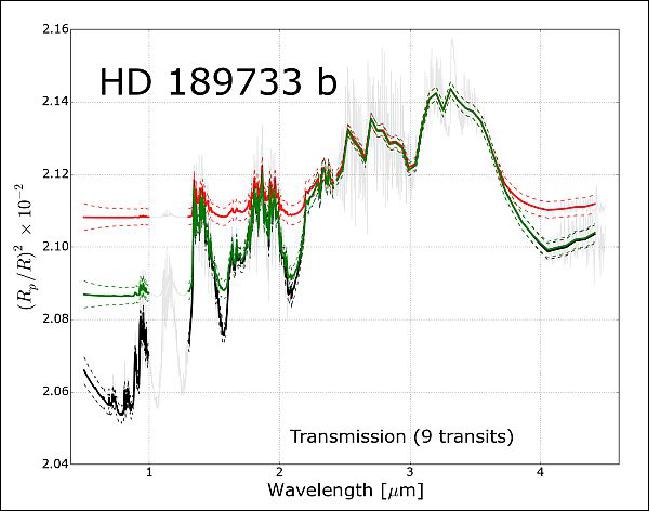
The CRM (Cardiff Radiometric Model) provides a static (non-time-domain) simulation of the detection by implementing a radiometric description of the coupling of the instrument with the focal plane detector array as well as a representative description of the most important noise sources and methods utilised to reconstruct the spectral information from measurements. The CRM is most useful for studying the relative importance of noise sources in the instrument noise budget and performing quick estimates of the confidence of the detection. Temperature limits on critical subsystems for example have been set this way.
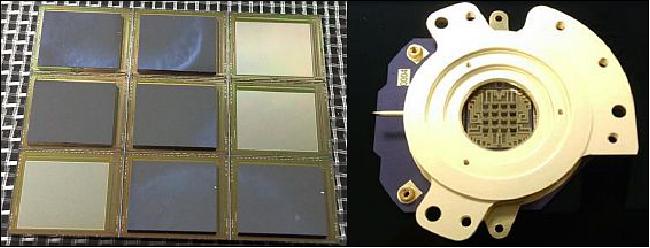
RALCAM4 (Rutherford Appleton Laboratory Camera-4)
Twinkle will collect light from its target planetary systems using a telescope based on a modified telescope system, called RALCAM4, developed by STFC's (Science and Technology Facilities Council ) RAL Space facility for Earth observation missions. Behind a 50 cm class primary mirror, a series of small mirrors will fold the light to fit the space limitations.
To compensate for the small movements of Twinkle during science observations, a steerable 'tip-tilt' mirror will focus a steady beam of incoming light into the science instrument package. There, the light will be filtered to remove unwanted wavelengths and divided into inputs for the two spectrometers.
The Twinkle instrument is composed of an optical-IR spectrograph (0.5 - 5 µm) with resolving power of R~300. The payload is made of off-the-shelf components built by UK institutes and industries. The instrument design benefits from the expertise developed at UK institutions over a wide number of funded space missions (e.g. Planck, Herschel, JWST-MIRI, ISO as well as the phase-A study of the EChO (Exoplant Characterization Observatory) mission concept. 12)
Twinkle's highly stable instrument will allow the spectroscopic observation of a wide range of planetary classes around different types of stars, with a focus on bright sources close to the ecliptic. The planets will be observed through transit and eclipse spectroscopy, as well as phase curves, eclipse mapping and multiple narrow-band time-series. The wavelength range adopted covers all the expected key atmospheric gases, e.g. H2O, CO2, CH4, NH3, HCN, H2S, including exotic metallic compounds, such as TiO, VO, SiO and condensed species. It will also permit the simultaneous monitoring of the stellar variability and the presence and distribution of clouds and hazes in the exoplanet atmosphere. Monitoring the weather and thermal properties of these planets, through repeated measurements in the optical and infrared wavelength bands will be a key aspect of this mission.
There are a number of significant design drivers for the TWINKLE telescope:
- A minimum entrance pupil diameter of 450 mm with a low obscuration ratio to meet the flux requirements.
- An accessible exit pupil where a steering mirror can be located for tracking during observations (due to the limitations of the spacecraft stability).
- Sufficient space around the focal plane position to accommodate the IR spectrometer, visible spectrometer, FGS and dichroics.
- An F number>10 input to match the spectrometer requirements.
- An exit pupil to image plane distance of ~250 mm to match the spectrometer input requirements.
- FOV ±3 arsec (up to 5 arcsec) with minimal variation of the image quality.
- Overall length to keep within the SSTL platform constraints and low cost launch option compatibility.
- Wavelength range 0.5 µm < λ < 4.5 µm.
- Good straylight control.
During the study, it became apparent that the best available solution was a Korsch type TMA. These designs are being used extensively in Earth Observation camera systems, including a Rutherford Appleton Laboratory Space camera - RALCAM4. 13) Fortuitously, RALCAM4's specification already closely matches those above for Twinkle so was an obvious choice to use as a basis to develop the Twinkle design.
The optical layout and the CFRP (Carbon Fiber Reinforced Polymer) structural model of RALCAM4 are shown in Figure 9.
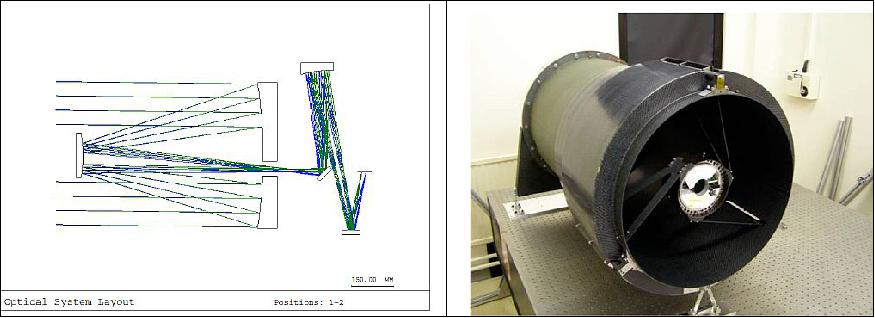
Although the RALCAM4 design could easily deliver an image quality close to the diffraction limit (in the visible) it required significant tweaking to ensure that the pupil position and packaging requirements could be met. The final design is shown in Figure 10.
The telescope design is based on an annular field Korsch telescope which has an obscured central field. In this case the project is using an off-set field of ~1° to use an unobscured FOV and to ensure that there aren't any beam clashes with the other mirrors. For packaging, there is an added fold mirror just behind the primary mirror (M1) which is close to the intermediate image plane. The final flat mirror at the exit pupil provides tip/tilt/focus control, and also allow the system to be folded within the space envelope required. The tip/tilt mirror can be controlled to keep the star image static (using the FGS) at the input to the spectrometers.
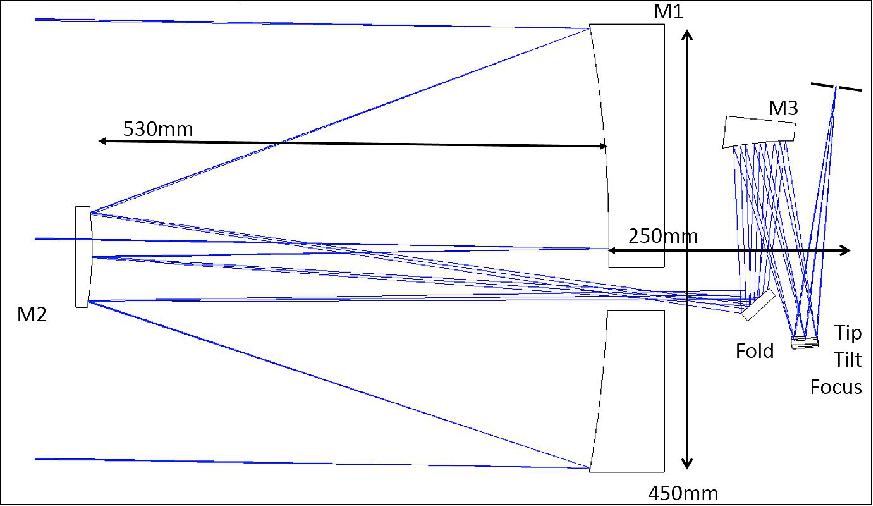
Secondary mirror mount and alignment: There are two current options for the mount of the secondary mirror (Figure 11). The first mounting solution adopts the RALCAM4 design based on three CFRP struts which link the secondary to one of the bulkheads surrounding the telescope baffle. This solution is shown in figure in the RALCAM4 telescope design alone and within the SSTL-300 platform. In the same figure, the mounting structure of the RALCAM4 can be seen on the "bottom side" of the baffle structure. This is not the foreseen telescope mount interface to the platform.
The second solution adopts metering rods which would allow good thermal expansion at the expense of mount complexity given the reduced size of the secondary mirror.

ELVIS (Exoplanet Light Visible Spectrometer)
ELVIS is a visible spectrometer channel based on the UVIS (Ultraviolet and Visible Spectrometer) instrument channel launched on the TGO (ExoMars Trace Gas Orbiter) mission in March 2016. For TGO, UVIS measures ozone, dust and aerosols in the martian atmosphere via observations of the Mars surface (in nadir mode) or the sun (in occultation mode) through the atmosphere.
The spectrometer is based on a Czerny-Turner optical configuration. The spectrometer configuration combines simplicity and high-performance, with a broad spectral range of 200-650 nm and optimized performance in the UV range. Internally the spectrometer uses a UV coated back-illuminated e2V CCD 30-11 as its detector and a grating that gives UVIS a spectral range of 200-650 nm at a resolution of ~ 1.5 nm. The combined instrument has a SNR (Signal to Noise Ratio) of >500 in nadir and >1000 in SO (Sun Observation). An image of the UVIS flight model is shown in Figure 12.
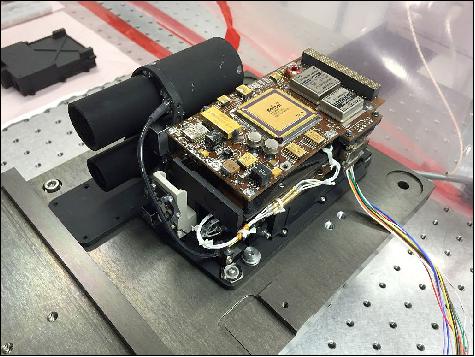
Optical spectrometer (modifications to UVIS):
For the Mars application the UVIS instrument used a dual telescope configuration; nadir (downward viewing of the surface for total atmospheric column measurements) and solar occultation observations (SO, looking at the Sun through the atmosphere from orbit to measure vertical profiles). The telescopes were connected to a single spectrometer via a fiber optic selector link. This telescope and selector system is not required in the Twinkle application as the spectrometer is positioned in the visible beam of the main Twinkle telescope (RALCAM4).
The main modification to the spectrometer design is the use of an alternative grating and associated coatings to optimize the spectral range to the visible to near IR range between 0.4 and 1.0 µm.
Other planned changes include a minor electronics component change on the detector board and relocation of the main electronics board stack to improve thermal isolation and allow the detector to run at a lower temperature. Changes to the firmware code within the electronics will optimize the operations (e.g. CCD readout modes) and integration times for the Twinkle application.
Detectors and readout: The CCD30-11 is an advanced inverted mode operation (AIMO) back-Illuminated (BI) high performance three-phase buried channel CCD; details on the CCD are provided in Table 3. The CCD was produced using the e2v QE (Quantum Efficiency) enhanced process with an optical coating applied to the CCD to increase the QE over the wavelength range. The addition of a boron implant under the integrating electrode defines a fixed potential well when the electrodes are all held at 0 V, which allows charge collection to be performed with the whole surface inverted minimizing dark current generation and allowing the device to be operated at warmer temperatures.
Wavelength range, Resolution | 400 – 1000 nm, ~2 nm |
Detector: image area | 26.6 mm x 6.7 mm |
Active pixels (H), Active pixels (V) | 1024, 255 |
Under-scan, Over-scan | 8 pixels, 8 pixels |
Pixel size | 26 µm x 26 µm |
Infrared Spectrometer
The objective of the infrared spectrometer is to study atmospheric features in bright exoplanets, such as "hot-Jupiters" and "super-Earths" orbiting close to their star. These features include the spectral fingerprints of water vapor, carbon dioxide, methane, ammonia, hydrogen cyanide, hydrogen sulphide, as well as exotic metallic compounds such as titanium monoxide, vanadium monoxide and silicon oxide. The infrared spectrometer has been designed by STFC's UK ATC (Astronomy Technology Center) and takes on board design heritage from the James Webb Space Telescope's MIRI (Mid Infrared Instrument). 14)
The goal of this design is to allow from a single incoming high F-number beam, the split in two separate channels (given the broadband nature of the desired spectral coverage) each with an appreciable spectral resolution (initially of the order of ~100 or more). The use of a narrow slit for the source and background to reduce the amount of stray-light by facilitating baffling internally within the instrument was suggested initially and also evolved in the iterations to a separate slit for the source and for the background field for subtraction.
The IR Instrument consists of two spectrometers which are intricately connected even though they only share one common optical element within the instrument (after the telescope optical train). The spectrometers work by delivering diffraction limited image over two spectral bands, 1.3-2.42 µm and 2.42-4.5 µm with resolving powers of R = 300 and R = 70 respectively. Figure 13 shows a perspective ray-tracing of the instrument albeit a full set of projections is needed to fully appreciate the propagation of rays through the optical system starting from the prism beam-splitter and ending on a common detector.
The layout of the optics of the two channels of the instrument has been checked for non-invasive presence of optical elements in each other's beams.
The nature of the input rays to the detector is such that no small-aperture enclosure can separate the detector arrays from the rest of the instrument. But given that a lengthy side baffle reduces the throughput incoming from the warmer instrument box shield by a considerable amount, a rectangular section shield is added for this purpose
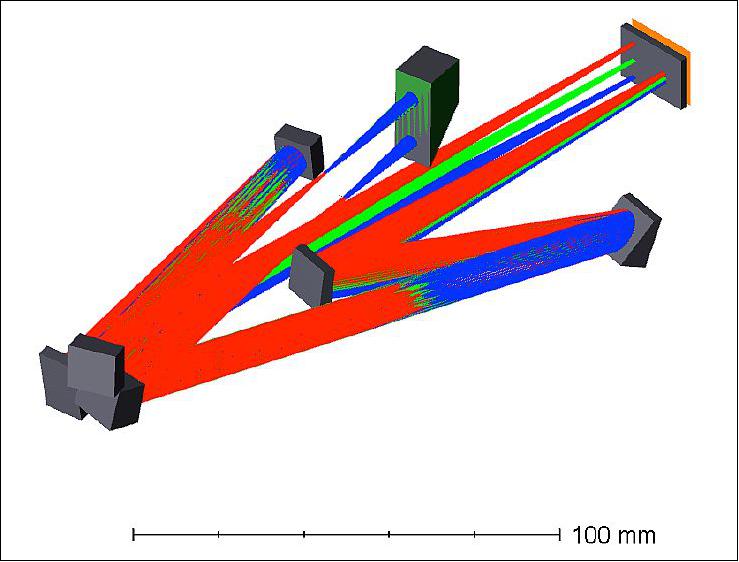
Inner optics: The spectrum of the star is separated into channel 1 (1.3 - 2.42 µm) and channel 2 (2.42 - 4.5 µm) by the CaF2 dichroic prism. There are instrument slit masks in each channel that act to limit the background flux entering the spectrometer. For light from the star and associated planet(s) the PSF (Point Spread Function) is the effective slit width while for the background the physical width of the slit is used. These slit widths combined with dispersing element, collimator and camera mirrors and detector pixels determine the spectral resolving power.
The length of the slits is determined by the available area of the detector, this is 60 arcsec for channel 1 and 112 arcsec for channel 2. The slit mask also represents the only access to an enclosed area which effectively shields most of the instrument from stray light reducing the constraints on the telescope baffle.
Wavelength (µm) | 2.44 λ/D (arcsec) | Linear size at slit (mm) | λ/D | Linear size at slit (mm) |
1.3 | 1.45 | 0.036 | 0.60 | 0.015 |
2.4 | 2.68 | 0.067 | 1.10 | 0.027 |
4.5 | 5.03 | 0.126 | 2.06 | 0.051 |
The beams leaving the 2 entrance slits are collimated by 2 diamond turned mirrors which in turn direct light towards the dispersing elements, a diffraction grating for channel 1 and a calcium fluoride prism for channel 2. The spectra are then imaged on to the detector by 2 more diamond turned mirrors. The spectra are aligned to lie along columns of pixels by rotating the grating/prism about their optical axes.
Detector arrays such as those proposed for Twinkle can present a variation in the QE (gain) at the sub-pixel level. This means that jitter in the star position along the entrance slit can result in appreciable changes in signal level. To reduce this effect an array of cylindrical lenses is placed in front of the detector that, in the cross-dispersion direction, image the telescope pupil onto the detector. This means that the movement of the star at the instrument entrance focal plane is translated into a change of angle of incidence at the detector, which results in a smaller change in signal than a direct lateral shift.
Fine Guidance System
In addition to the optimized instrument design to reduce the effect of pointing jitter, a visible FGS (Fine Guidance Sensor) camera is placed at the Instrument Optical Bench downstream from M5 and in reflection of the dichroic and beam-splitter that balances the outputs between FGS and ELVIS. This optical camera will be a standard 1024 x 1024 CCD with a working FOV (Field of View) of ± 3 arcmin. The camera (or a portion of the array) will be read-out at high-speed and the centroid of the star of interest calculated to better than a tenth of a pixel (~0.03 arcsec). In-flight calibration and commissioning will allow to establish the corresponding working position for the mask slits on the FGS in order for the TTM (Tip-Tilt Mirror) control electronics to keep the source stable within the slit.
Pointing jitter typical of the platform and first derivative of known sources of pointing drifts, allow the TTM to perform well within operating parameters with a payload-in-the-loop arrangement only needed where the source is at risk of exiting the corrected FOV of the FGS, reducing complexity in the payload-platform communication.
The TTM mechanism is based on the heritage design of the Herschel BSM (Beam Steering Mechanism). The size of the mirror is almost identical with a similar hole at the aperture plane which will allow the presence of a calibration source if warranted by further simulations. The active mechanism requirements can be relaxed in comparison with the Herschel model given the higher temperature (>120 K) compared to the ~4 K version. Finally, the mechanical frame and balancing weight of the TTM will be increased in size to account for the shift in axis of one of the two mechanisms (tilt) given that the angled focal plane requires a simultaneous de-focus to avoid enlarging of the PSF at the masks.
Mini-Coolers
The coolers adopted to provide the necessary working temperature for the IR detectors (70 K) and the reduced operating temperature for the instrument optics and telescope are two Stirling-cycle mini-coolers developed at RAL-Tech (Rutherford Appleton Laboratory Technology department) under an ESA Technology Readiness Program contract. The small scale cooler prototype is shown in Figure 14 together with a plot showing the linear scale of heat lift versus the temperature of operation of the cold head.
Mass, size | 620 g, 145 mm x 70 mm x 95 mm |
Input power, heat lift | 22 W, 500 mW @ 77K |
Stability (without PID control) | ±5 mK 10 minutes, ±30 mK 1hr |
mVib (unbalanced displacer), mVib (two back-to-back) | 3 Npk @ 90 Hz, 0.3 Npk @ 90 Hz |
CCE (Cooler Control Electronics) | Open loop simple COTS controller |
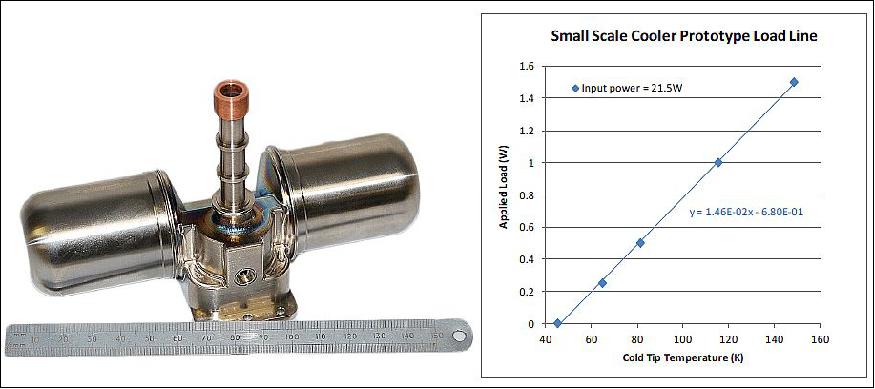
The Stirling cycle cooler comprises a pair of linear motor reciprocating compressor units and a single, similarly driven, displacer unit orthogonal to the compressor axis. In the prototype small scale cooler the displacer is unbalanced, although a momentum compensator is commonly employed on larger versions of the cooler. The life and reliability of the cooler stems from the philosophy non-lubricated, non-contacting moving parts, that are enabled by a flexure bearing suspension system operating in the infinite fatigue strength regime.
Accessing Twinkle
As of 2016, the Twinkle project is engaging international customers, who can: (Ref. 5)
- Purchase spaceborne telescope time for VIS-IR observations of astrophysical objects (e.g. exoplanets, solar system bodies, stars, disks)
- Purchase observations of exoplanet targets of interest from the mission catalog
- Get exclusive access, via encrypted transfer, to the data within days of the observation.
Twinkle will deliver:
- The first simultaneous broad wavelength range spectral observations of 100+ exoplanets
- The first dataset optimized for characterizing exoplanet atmospheres
- The first thermal maps of exoplanets and their cloud cover at multiple wavelengths in the optical and infrared parts of the spectrum
- Repeated observations of exoplanets, e.g. to monitor changes in climate and atmospheric composition
- Ability to follow up in the IR exoplanets or exoplanetary candidates identified with other space/ground facilities
- Ability to monitor stellar variability through time, at multiple wavelengths
- A fast access to VIS-IR observations from space of solar system or bright astrophysical objects
- Opportunities for all countries to access space astrophysical data without restrictions
- An allocation of public data for citizen scientists, amateurs and students.
Benefits that Twinkle can offer, include:
- It can be used by universities, countries and organizations that usually have little or no access to the large international facilities
- It will help to alleviate the oversubscription burden on the existing international multipurpose observatories
- It complements the planned exoplanet hunter and characterization missions
- Pioneers a program which can routinely enable answering suitable key science questions with smaller dedicated observatories on a commercial basis and therefore
- Can start to relieve some of the budgetary and complexity trade-offs faced on the larger multipurpose facilities
- In general, this wider access to new astrophysical data will stimulate new research and the resultant discoveries and publishing will encourage increased STEM uptake and public engagement.
Our team is currently engaging prospective customers and partners. Please contact info@bssl.space for further information.
References
1) "Twinkle: A British mission to explore Exoplanets," SSTL, January 2015, URL: https://web.archive.org/web/20170222133101/http://www.sstl.co.uk/Blog/January-2015/Twinkle-A-British-mission-to-explore-Exoplanets
2) "How are exoplanets found?," May 2015, URL: https://bssl.space/how-are-exoplanets-found/
3) Marcell Tessenyi, Giovanna Tinetti, Jonathan Tennyson, Giorgio Savini, Enzo Pascale, Susan Jason, Doug Liddle, James Williams, Amar Vora, Chris Saunders, "Twinkle – a British space mission to explore faraway worlds," Proceedings of the 66th International Astronautical Congress (IAC 2015), Jerusalem, Israel, Oct.12-16, 2015, paper: B4.21
4) S. Jason, A. da Silva Curiel, M. Tessenyi, G. Tinetti, G. Savini, J. Tennyson, E. Pascale, J. Williams, G. Johnson, S. Prasad, A. Vora, C. Saunders, J. Friend, M. Sweeting, "Twinkle: A new idea for commercial astrophysics missions," Proceedings of the 4S (Small Satellites, System & Services) Symposium, Valletta, Malta, May 30-June 3, 2016, URL: http://www.twinkle-space
mission.co.uk/media/4Spaper_Twinkle.pdf
5) Marcell Tessenyi, Giovanna Tinetti, Jonathan Tennyson, Giorgio Savini, Enzo Pascale, Susan Jason, Alex da Silva Curiel, James Williams, Gavin Johnson, Simon Prasad, Amar Vora, Chris Sounders, Jonathan Friend, "Twinkle – a mission to unravel the story of planets in our galaxy," Proceedings of the 67th IAC (International Astronautical Congress), Guadalajara, Mexico, Sept. 26-30, 2016, paper: IAC-16-B4.2.5
6) A. Tsiaras, M. Rocchetto, I. P. Waldmann, O. Venot, R. Varley, G. Morello, M. Damiano, G. Tinetti, E. J. Barton, S. N. Yurchenko, J. Tennyson, "Detection of an atmosphere around the super-Earth 55 Cancri e," Draft version, February 9, 2016, URL: https://arxiv.org/pdf/1511.08901v2.pdf
7) "Exoplanet Mission Completes Design Milestone," Space Daily, June 21, 2016, URL: http://www.spacedaily.com/reports/Exoplanet
_Mission_Completes_Design_Milestone_999.html
8) "Twinkle exoplanet mission completes design milestone," Twinkle Space Mission Press Release, June 16, 2016, URL: http://www.twinkle-spacemission.co.uk
/media/Twinkle_press_release16_6_16.pdf
9) "Twinkle exoplanet mission completes design milestone," Twinkle Press Release, June 16, 2016, URL: http://www.twinkle-spacemission.co.uk
/media/Twinkle_press_release16_6_16.pdf
10) 'Twinkle' exoplanet mission completes design milestone," Optics.org, June 20, 2016, URL: http://optics.org/news/7/6/29
11) G. Savini, M. Tessenyi, G. Tinetti, C. Arena, J. Tennyson, T. Zingales, E. Pascale, R. Sudiwala, A. Papageorgiou, S. Sarkar, P.A.R. Ade, M. J. Griffin, K. Barnes, L. Hipwood, P. Knowles, M. Patel, M. Leese, J. P. Mason, I. Tosh, A. Saad, P. Eccleston, B. Shaughnessy, T. Brooke, M. Wells, I. Bryson, A. MacLeod, W. Taylor, N. Bezawada, G. S. Wright, S. Jason, J. Friend, J. Williams, G. Johnston, S. Prasad, A. Vora, C. Saunders, "Twinkle – A Low Earth Orbit Visible and Infrared Exoplanet Spectroscopy Observatory," Preprint of a SPIE Proceedings paper, 'Astronomical Telescopes + Instrumentation conference,Edinburgh, UK, June 26- July 1, 2016, paper: 9904-175, URL: http://www.twinkle-spacemission.
co.uk/media/SPIE_preprint_Twinkle.pdf
12) Giovanna Tinetti, Pierre Drossart, "Topical issue on EchO -the Exoplanet Characterization Observatory," Experimental Astronomy, Volume 40, Issue 2-3, pp: 327-328, DOI 10.1007/s10686-015-9487-5, December 2015, URL: http://tinyurl.com/zs6cqn2
13) George Tyc, Wade Larson, Tim Butlin, Nick Waltham, Nigel Morris, Ian Tosh, "High Performance Optical Imaging Payloads for Smallsat Missions," Proceedings of the 22nd Annual AIAA/USU Conference on Small Satellites, Logan, UT, USA, Aug. 11-14, 2008, SSC08-VI-6, URL: http://digitalcommons.usu.edu/cgi/view
content.cgi?article=1385&context=smallsat
14) Martyn Wells, "The infrared spectrometer for Twinkle,"Proceedings of the SPIE Astronomical Telescopes and Instrumentation C conference,Edinburgh, UK, June 26- July 1, 2016paper: 9904-176
The information compiled and edited in this article was provided by Herbert J. Kramer from his documentation of: "Observation of the Earth and Its Environment: Survey of Missions and Sensors" (Springer Verlag) as well as many other sources after the publication of the 4th edition in 2002. - Comments and corrections to this article are always welcome for further updates (eoportal@symbios.space).
Overview Spacecraft Launch Sensor Complement References Back to top